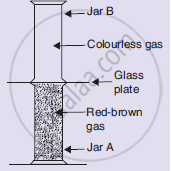Advertisements
Advertisements
प्रश्न
The substance X normally exists in a physical state which can flow easily but does not fill its vessel completely. It also turns anhydrous copper sulphate blue. When substance X is cooled excessively, it changes into a substance Y which has a fixed shape as well as a fixed volume. If, however, the substance X is heated strongly, it changes into a substance Z which has neither a fixed shape nor a fixed volume.
- Name the substances (i) X (ii) Y and (iii) Z.
- What is the process of conversion of X into Y known as ?
- At which temperature X gets converted into Y ?
- What is the process of conversion of X into Z known as ?
- At which temperature X gets converted into Z ?
उत्तर
- the substances X, Y and Z are water, ice and steam, respectively.
- The process of conversion of X into Y is known as freezing
- At 0°C X is converted to Y.
- Boiling or vaporisation is the name of the process of conversion of X to Z.
- At 100°C X gets converted to Z.
APPEARS IN
संबंधित प्रश्न
Give reasons:
A gas exerts pressure on the walls of the container.
Why do gases have neither a fixed shape nor a fixed volume?
Give one example of diffusion of gases in a liquid.
Explain why, diffusion occurs more quickly in a gas than in a liquid.
Why do gases diffuse very fast?
Why does a gas exert pressure?
When a gas jar containing colourless air is kept upside down over a gas jar full of brown-coloured bromine vapour, then after some time, the brown colour of bromine vapour spreads into the upper gas jar making both the gas jars appear brown in colour. Which of the following conclusion obtained from these observations is incorrect?
Look at the diagram on the right side. Jar A contains a red-brown gas whereas jar B contains a colourless gas. The two gas jars are separated by a galas plate placed between them
- What will happen when the glass plate between the two jars is pulled away?
- What name is given to the phenomenon which takes place?
- Name the brown gas which could be in jar A.
- Which is the colourless gas most likely to be present in jar B?
- Name one coloured solid and one colourless liquid which can show the same phenomenon.

______ is not affected by gravity.
How does the substance of gaseous particles change to a liquid state?
